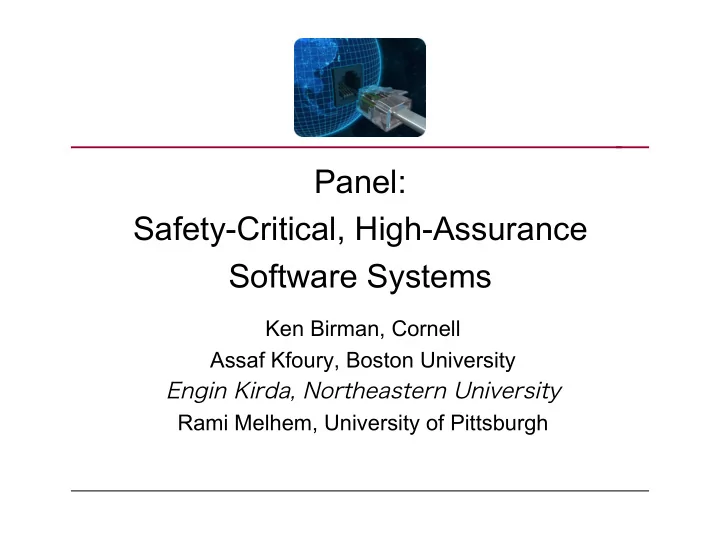

Engin Kirda, Northeastern University Panel: Safety-Critical, High-Assurance Software Systems Ken Birman, Cornell Assaf Kfoury, Boston University Rami Melhem, University of Pittsburgh
Overview of Panel • This panel is on safety-critical, high-assurance systems – I am a systems security person – hence, this is not necessarily my main area of research ;) – However, the security of critical systems is increasingly gaining focus and attention – There have been documented, high-profile attacks against critical systems (e.g., Stuxnet) • This panel aims to discuss – Promising research directions – Current research challenges – How we can foster more collaboration Safety-Critical, High-Assurance Systems
Background: Critical Systems • Critical systems control public resources such as electricity, water, telecommunications, banks, etc. • The consequences of any disruption of service are severe and may result in loss of human life • Such systems must often consider different types of constraints compared with regular computer systems (e.g., real time) • Interdependencies between subsystems may lead to cascading effects that are difficult to foresee • There is an emphasis on safety and less understanding of computer security in this domain (and vice versa) Safety-Critical, High-Assurance Systems
Examples of Critical Systems • ”Traditional” critical infrastructures – electricity, water, telecommunications, etc. • SCADA systems – Used in almost all critical infrastructures – Efforts are already ongoing to protect such systems • Financial systems are critical infrastructures – Many access points – Availability to many and diverse users Safety-Critical, High-Assurance Systems
“Emerging” Critical Systems • Data centers are becoming common and these can be seen as CIs in that they provide data necessary for more traditional CIs • In-vehicle automation with remote diagnostics and software updates for vehicles – Embedded (automobile) systems connected to open networks. – Some of the problems related to any embedded system are also valid for the connected car Safety-Critical, High-Assurance Systems
Safety takes priority over security • Problem: In the domain of critical systems, both safety and security are important, but in certain scenarios, safety takes priority • If the underlying process is about to become critical, security should not block or delay appropriate remedies or counteractions • We need an integrated view on safety and security, since a breach in security could provoke a breach in safety Safety-Critical, High-Assurance Systems
Unforeseen cascading effects • Problem: Interconnected systems are difficult to model properly, and interdependencies between the subsystems, can lead to cascading effects that are difficult to foresee • We need to develop appropriate models for the domain, and an overall better architecture with a security baseline Safety-Critical, High-Assurance Systems
Use of new technology • Problem: Critical systems also use new types of technology to add functionality • e.g., wireless communication for remote sites and internal enterprise communication. Critical control communication will be wireless within 10 years • There is a tradeoff between the advantages gained with a technology versus the security risk • This trade-off must be carefully modeled and analyzed Safety-Critical, High-Assurance Systems
The Human Factor • Problem: The human is probably the weakest point in a critical system – The roles include operators in control rooms, engineers taking technical decisions, managers and decision-makers for future strategy development Adversarial problem : Insiders with experience of and knowledge about the system • Important issues: – Education and training, raising awareness of security risks; sound and evolving security policy; modeling the user (“cognitive modeling”) and user-interface properties. Effective strategies for discovering an “insider” is an open research question. Safety-Critical, High-Assurance Systems
The Next Challenge: Cyberwar • Stuxnet, Duqu, Flame – Government-sponsored malware attacks against other nations – How can we secure existing critical systems?
Recommend
More recommend